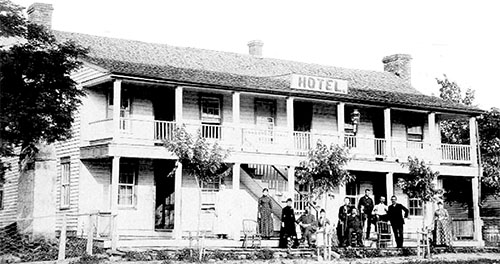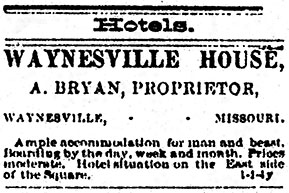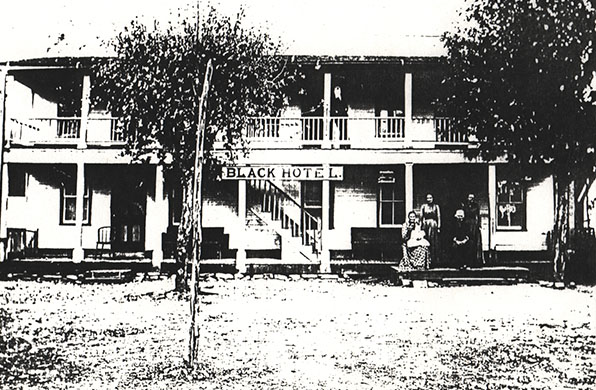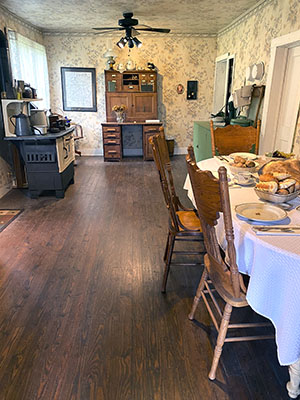gs rt sh.jpg)

Black Hotel Kitchen1915 |
gs rt sh.jpg) |
 |
| W. W. and Mary Jane McDonald sold their building and property in 1870 to William and Nancy Mitchell. They sold it to Alexander and Mary Bryan in 1874. If you looked at the Civil War images in the previous room, you noticed that the building was one-story with three rooms. In 1876 the Bryans raised it to two stories and the back lean-to rooms were added, considerably enlarging it to ten rooms. The picture at above left is the oldest photograph of the building we have and was probably taken not long after the raising. The picture at right appears to have been taken in the 1880s with Alexander Bryan, who was a big man, seated on the porch to the right. The earliest known name of the building, Waynesville House, was found in an 1876 newspaper. The description at the bottom of the ad reads, "Ample accommodation for man and beast. Boarding by the day, week and month. Prices moderate. Hotel situation on the East side of the Square." |  |
Alexander Bryan operated the Waynesville House for 12 years. He sold it to James and Emeline Vaughan in 1886. The Vaughans resold it that same year to James and Isabell Ross, who were W.W. McDonald's daughter and son-in-law. They operated it for two years then sold it to E. G. and Emiline Williams. The Williams kept it for two years and sold it to J. L. and Mary Johnson in 1890. The Johnsons renamed the hotel the Johnson House. The hotel changed hands again in 1894 when Lewis and Eliza Black purchased it. The Black family renamed the building as the Black Hotel and retained ownership until 1925. The picture at right was taken between 1897, the year grandson James Bostick was born, and 1899, the year Lewis Black died. Seated are Eliza, holding little James in her lap, and Lewis. Standing behind are daughters Grace (left) and Amanda. After Lewis died, Eliza and spinster daughter Amanda operated the Black Hotel together until Amanda died in 1915. The Old Stagecoach Stop Foundation restored the kitchen to 1915, the era of the Black Hotel. |
 |
 |
The kitchen was the hub of activity at the Black Hotel in the early part of the last century. Eliza and Amanda's family-style Sunday dinners were noteworthy among the locals. Eliza rang a big bell at 11:45 each day and the guests came running to eat a full meal which always included two or three meats and homemade breads—the price was 25 cents. That was also the daily room rental rate in the early 1900s. The hotel was also the venue for a considerable number of weddings each year. Traveling dentists and eye doctors would set up shop for week stays and offer their services to the townspeople. |
The large table is set with Alfred Meakin earthenware. Large quantities were imported from England at the turn of the century. We know it was used at the hotel as several plate sherds were unearthed in a salvage archaeological excavation, explained later in the tour, under the building. |
The tea leaf was one of the most popular of the Meakin patterns and used at the hotel. The table is also set with 1915 Rogers flatware and period embroidered cloth napkins. |
|
|
 |
Amanda Black (1863-1915) never married and shared the reponsibilities of running the hotel with her mother. Her facial disfigurement was the result of medical treatment with calomel, a mercury-based medicine, for intestinal disorders. Amanda seldom left the hotel without wearing a veil but was active in several women's service organizations. In the picture on the wall at left she is wearing a watch necklace. That pendant watch is displayed in the adjacent case. Both items were given to the Foundation by great-great-granddaughters of Eliza Black. The year 1915 was a tragic one for Eliza. Five of her eleven adult children met untimely deaths. Amanda succumbed to pulmonary tuberculosis. Mother Eliza, who was born in 1839, died in 1930 at the age of 91 years and one day old. |